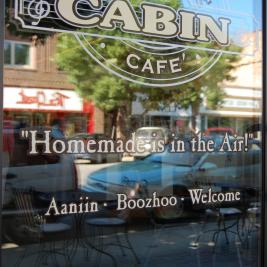skip to main |
skip to sidebar
American Indian Studies Ojibwe Language Weekend--'Ni'Shin!'By Brita BrookesThe Michigan State Department of Linguistics & German, Asian, Slavic, and African Languages, The American Indian Studies Program, and the North American Indigenous Student Organization sponsored and organized the weekend event “Learning and Living the Language” which created an environment where students and community members could be immersed in the Ojibwe language. As language Professor Helen Roy communicated on the event flyer, “it is our duty and our inherent nature as Anishinaabeg to preserve the language of our ancestors.”
The Pow Wow which was held at a local community center meeting room was done completely in the Ojibwe language. Third year Linguistics Student Autumn Mitchell read aloud two stories in Ojibwe while a projection screen on the wall projected artful illustrations of the storyline.
Bemidji businesses including Ojibwe in signsBy Tom Robertson Shared Vision member Michael Meuers came up with the idea of asking businesses to post signs in Ojibwe. Meuers' goal was to get 20 businesses signed on to the idea in the first year. But in just six weeks, nearly 60 businesses are on board.
That includes big organizations like Bemidji State University, the City of Bemidji and the local hospital. It also includes smaller organizations like Harmony Foods, a downtown health food cooperative that will soon produce Ojibwe labels for the fruits and vegetables in its produce section.
Meuers works with local Ojibwe language experts to help businesses with proper usage and spelling of Ojibwe words. He said a local funeral home has asked for an Ojibwe translation for a blessing for grieving families. Other businesses have asked for translation help for words like "pharmacist" and "we fix computers."
The Shared Vision group is working on strategies for tackling a wide range of complex race issues. But Meuers said the Ojibwe signs are a simple gesture, and the first tangible sign of progress.
"It's profound in its simplicity, and it's inexpensive to do," Meuers said. "The thought occurred to me that Indian people would look at this as a welcoming and a sign of respect. The non-Indians in the community would learn a little bit about the indigenous peoples that have been here for thousands of years, and the tourists would love it, so there's an economic side of it, too."
Virtual elder rekindles hope for revival of Canadian aboriginal languageThe Ktunaxa have been digitally archiving their language since 1999 and they built their own broadband network in 2007 in order to make a better use of these language training resources.
The 7.7-million-Canadian-dollars (about 7 million U.S. dollars) Ktunaxa Nation Network is currently the only native-owned open-fiber-to-the-home net work in North America, providing speeds of 100 megabits per second to each home.
"We're now wired like no other community in North America," Maki sadi. "Not many people get a chance to change the course of predicted history, but with hard work and fiber, we will."
Four community learning centers has been set up in each of the Ktunaxa communities, all of them are equipped with high speed internet and vedio-conferencing devices. Specially trained staff there offer online educational classes or technical assistance to band members.







